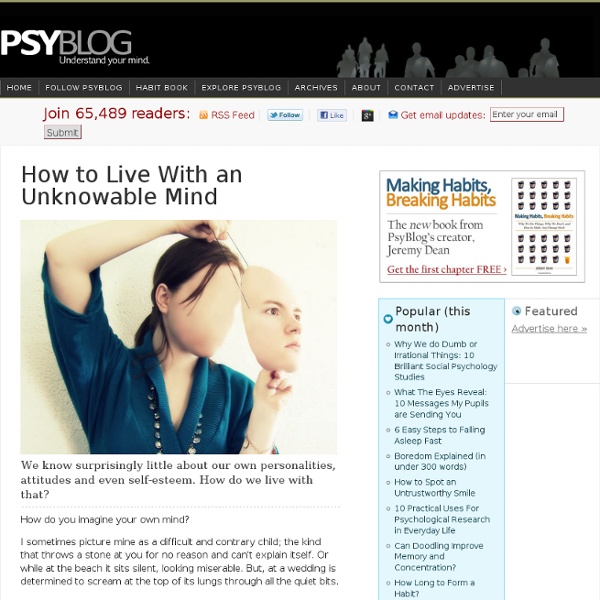Top 10 Thinking Traps Exposed
Our minds set up many traps for us. Unless we’re aware of them, these traps can seriously hinder our ability to think rationally, leading us to bad reasoning and making stupid decisions. Features of our minds that are meant to help us may, eventually, get us into trouble.
10 More Common Faults in Human Thought
Humans This list is a follow up to Top 10 Common Faults in Human Thought. Thanks for everyone’s comments and feedback; you have inspired this second list!
Me, Myself and My Stranger: Understanding the Neuroscience of Selfhood
Where are you right now? Maybe you are at home, the office or a coffee shop—but such responses provide only a partial answer to the question at hand. Asked another way, what is the location of your "self" as you read this sentence? Like most people, you probably have a strong sense that your conscious self is housed within your physical body, regardless of your surroundings. But sometimes this spatial self-location goes awry.
7 Ways to Stop Fearing What Everyone Thinks of You
Email The unhappiest people in this world are the people who care the most about what everyone else thinks. “What’s wrong with wanting to please others?” That’s what several people asked me via email in response to one of my recent articles. Today, I want to discuss why it’s not healthy to try to please everyone, and how to stop yourself from doing so.
To Let Go of Stress, Catch Your Breath: Ujayii Breathing How-To
When I first began practicing yoga in 1983, my teachers didn’t just tell me to breathe; they gave me explicit instructions on how to breathe, how to feel the sensations of breath, and how to become familiar with the muscles of respiration. When I began studying the Ashtanga style of yoga at age 22, I was introduced to ujayii pranayama, or the triumphant breath. It was a complete revelation to me. Breath equals life.
Color Psychology
by David Johnson Like death and taxes, there is no escaping color. It is ubiquitous.
INTP
Originally published in Wholeness Lies WithinCopyright © 1986-2002, Terence Duniho; © 2002-2010, Fergus Duniho The following description was written by my father and may reflect some of his personal experience with me, but he also spent plenty of time gaining firsthand knowledge of all the types through type conferences and workshops, and I was by no means the only member of my type known to him. During the mid 20th century, Carl Jung identified eight personality types and divided them into sixteen subtypes.
Thought for Food
‘The Door’ A familiar voice from everywhere, including within. The Door of Everything, by Ruby Nelson (DeVorss & Company), is more than a book that I’d recommend, it’s a way of seeing, thinking, and being, that is worthy of consideration, no matter who you are, or what your current belief orientation may happen to be. The ideas revealed in this tiny volume can, if the reader feels a resonance, liberate and transform, not just one’s life, but the world around. In all the world, in all time, as long as this book has been around, and as important its message, it has not been made available, either as an audio or video-book. Until now.
40 Ways to Let Go and Feel Less Pain
“If you let go a little, you will have a little peace. If you let go a lot, you will have a lot of peace.” ~Ajahn Chah Eckhart Tolle believes we create and maintain problems because they give us a sense of identity. Perhaps this explains why we often hold onto our pain far beyond its ability to serve us.
Dunning–Kruger effect
Cognitive bias about one's own skill The Dunning–Kruger effect is a hypothetical cognitive bias stating that people with low ability at a task overestimate their own ability, and that people with high ability at a task underestimate their own ability. As described by social psychologists David Dunning and Justin Kruger, the bias results from an internal illusion in people of low ability and from an external misperception in people of high ability; that is, "the miscalibration of the incompetent stems from an error about the self, whereas the miscalibration of the highly competent stems from an error about others".[1] It is related to the cognitive bias of illusory superiority and comes from people's inability to recognize their lack of ability. Without the self-awareness of metacognition, people cannot objectively evaluate their level of competence. Original study[edit]



